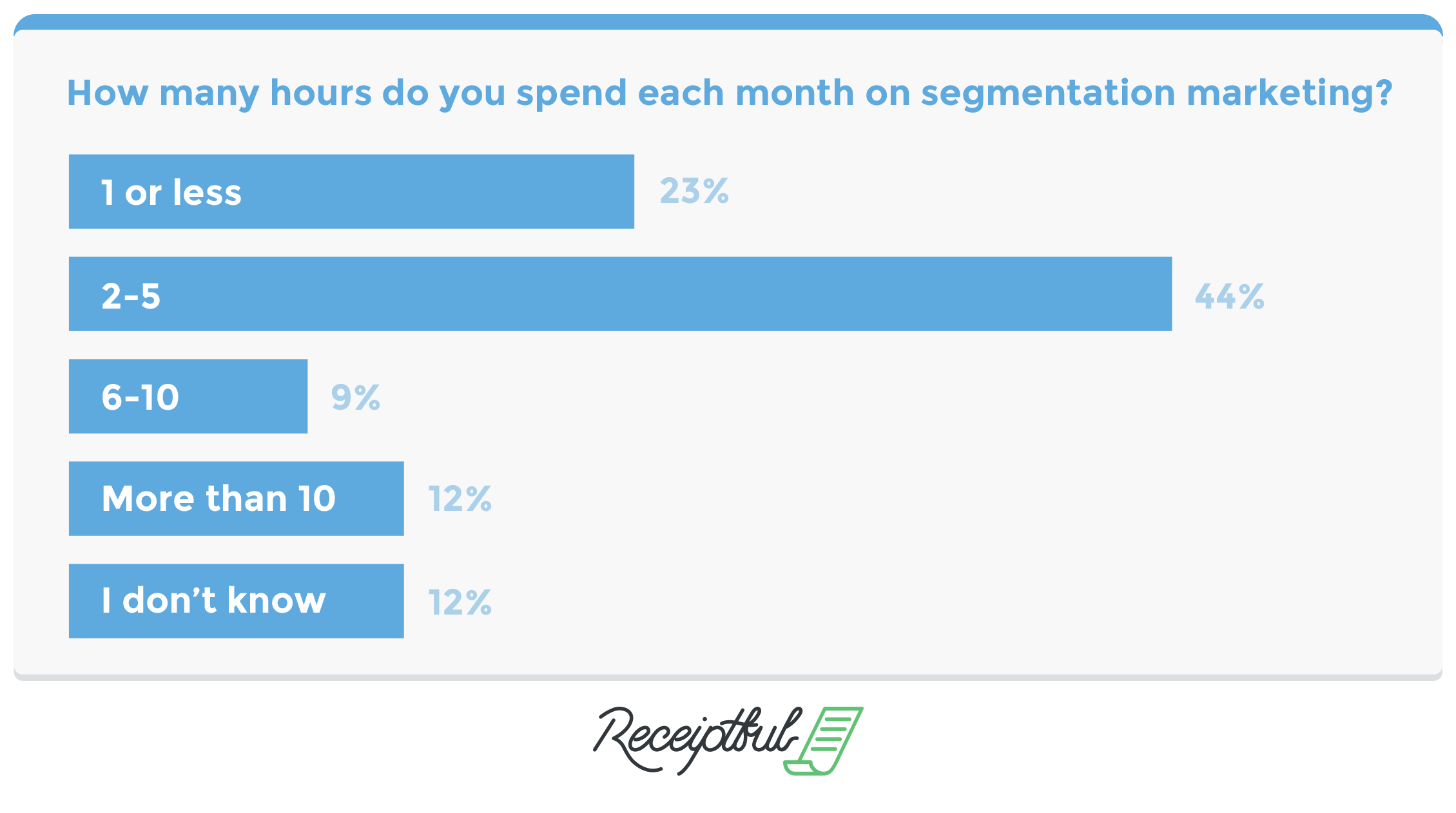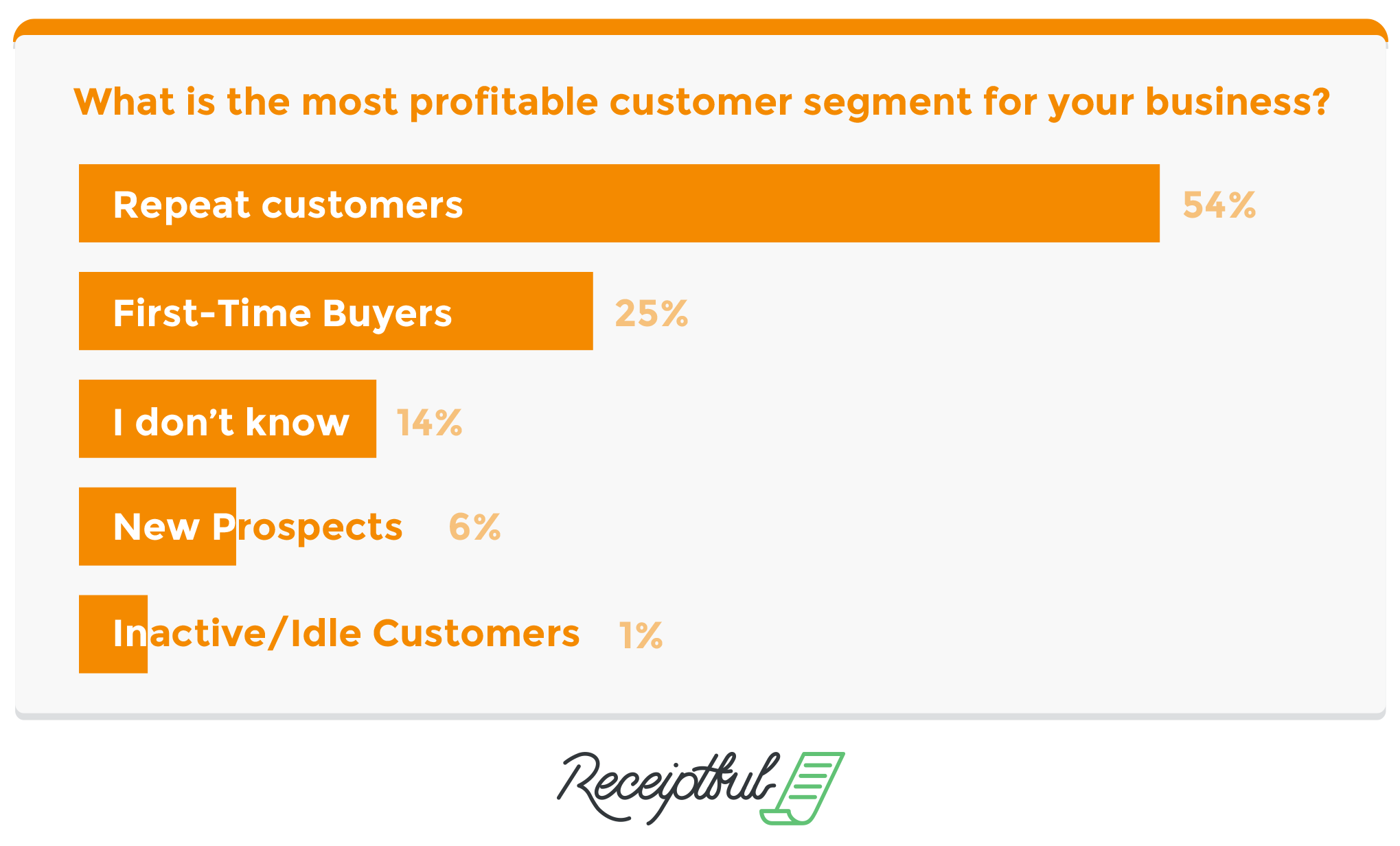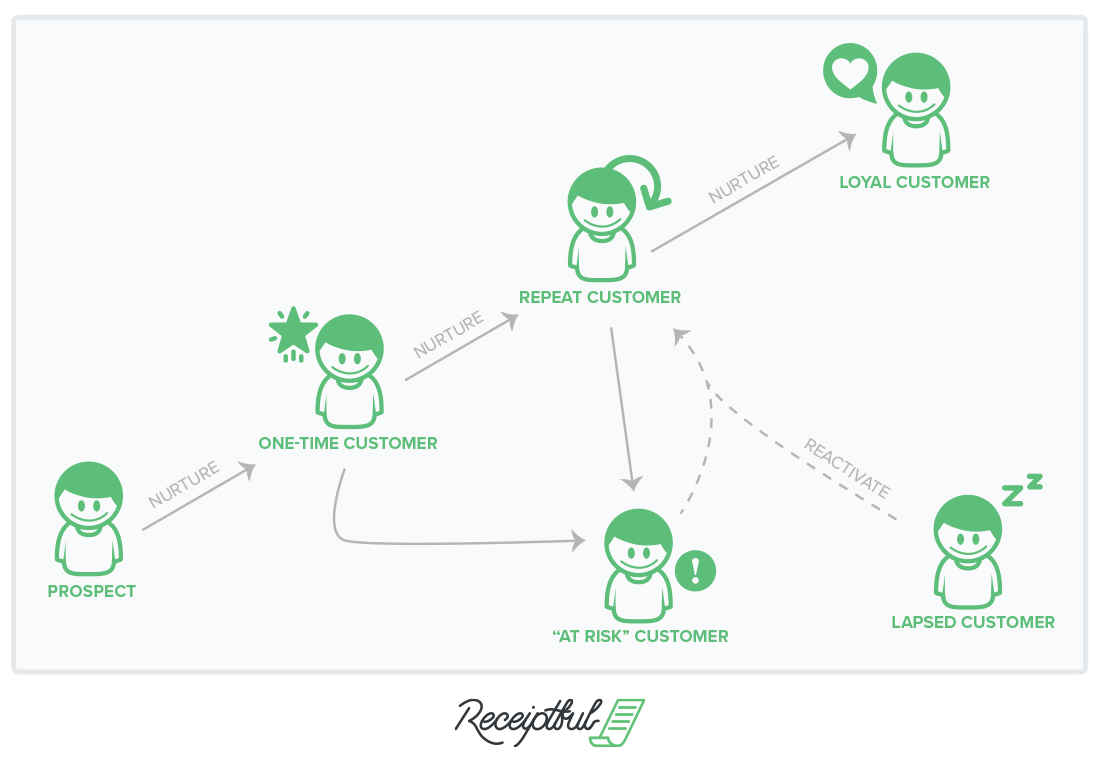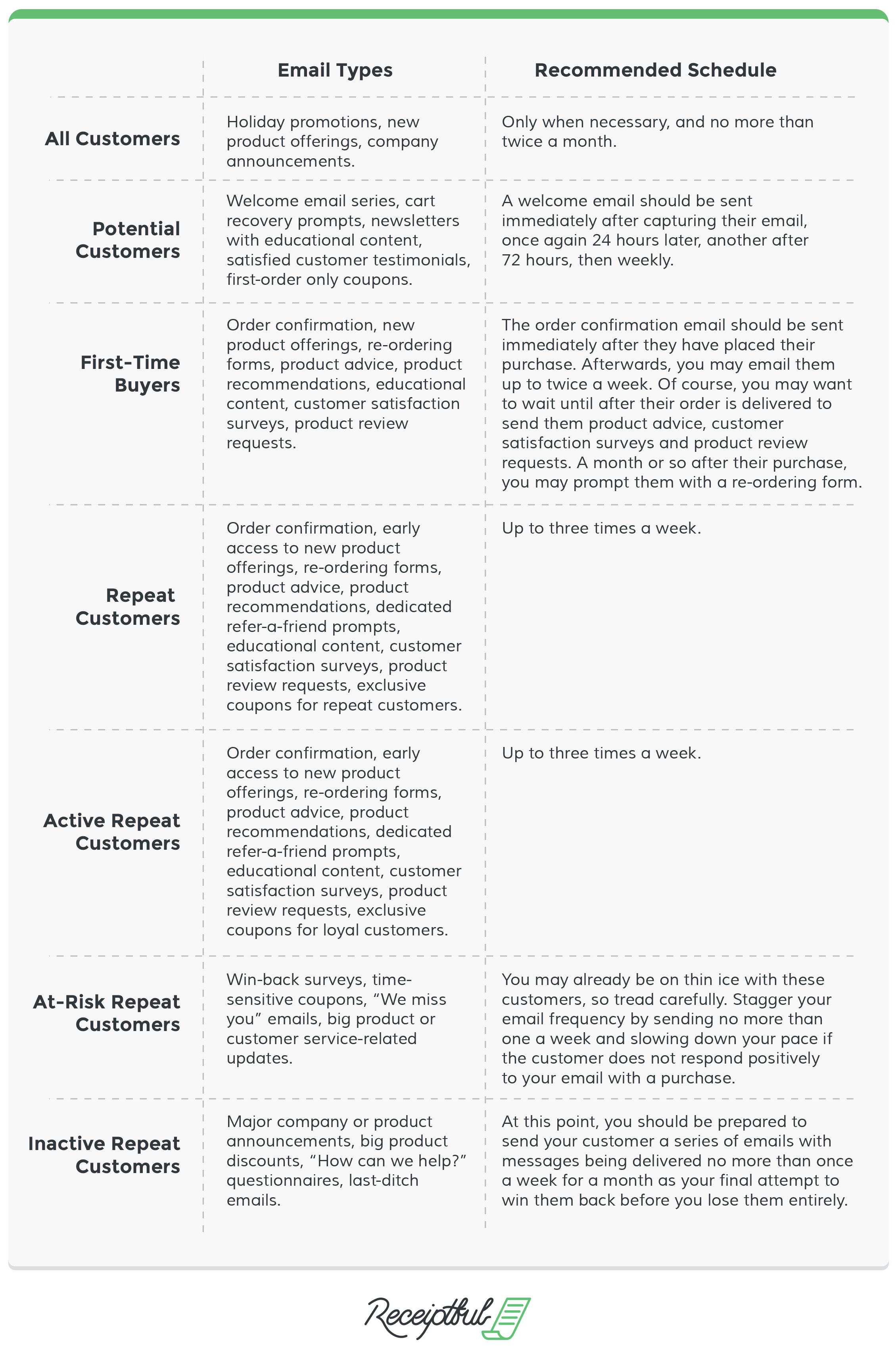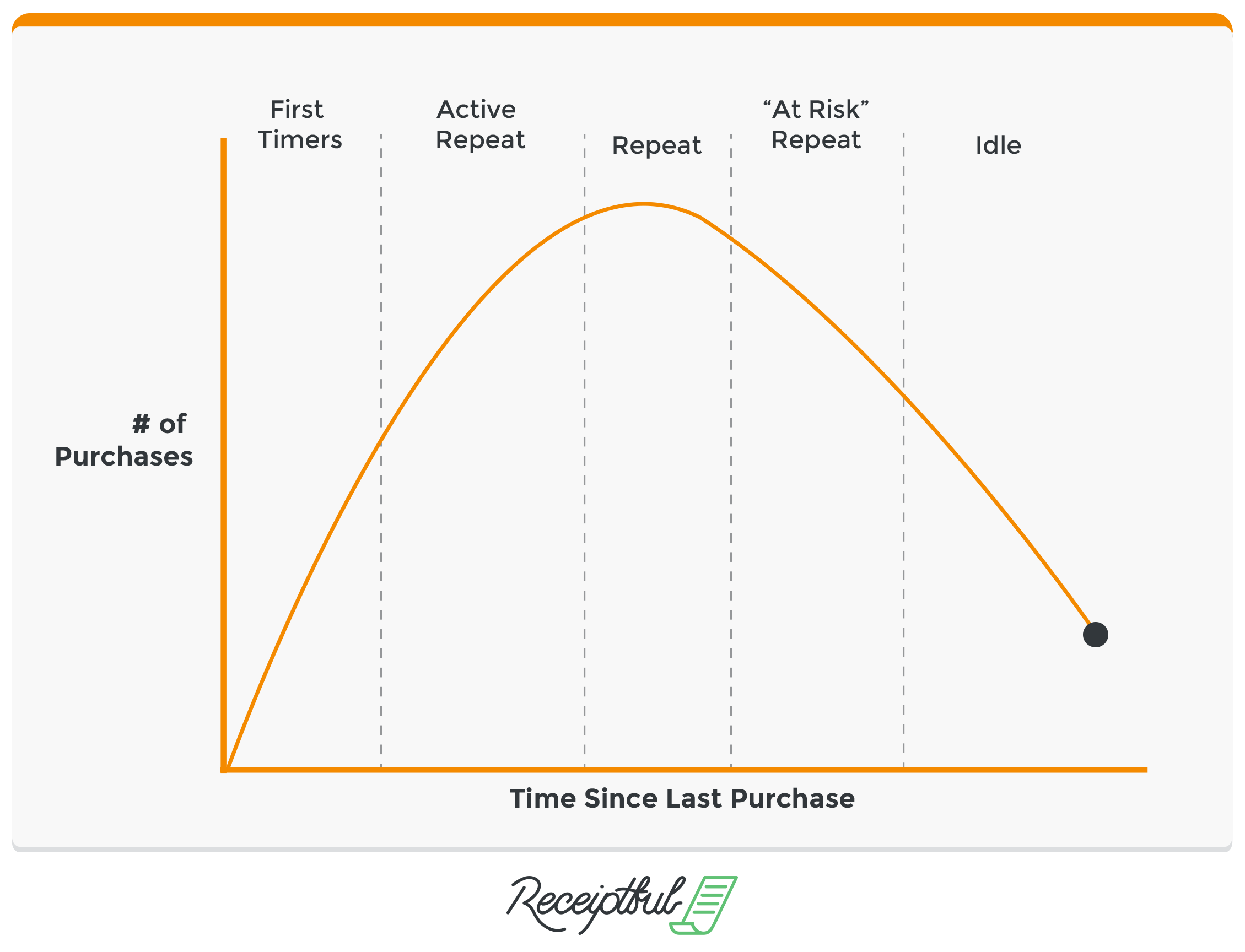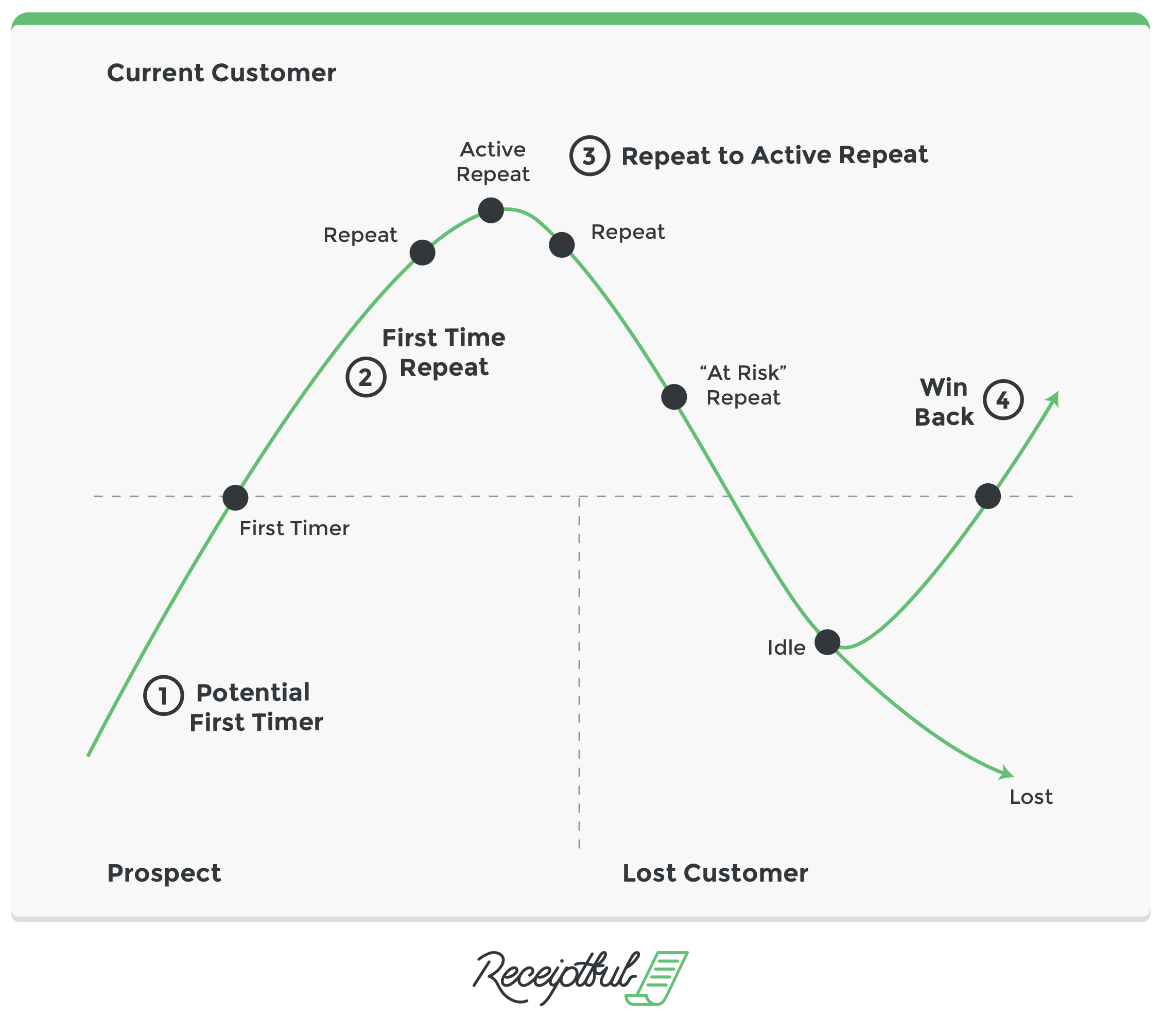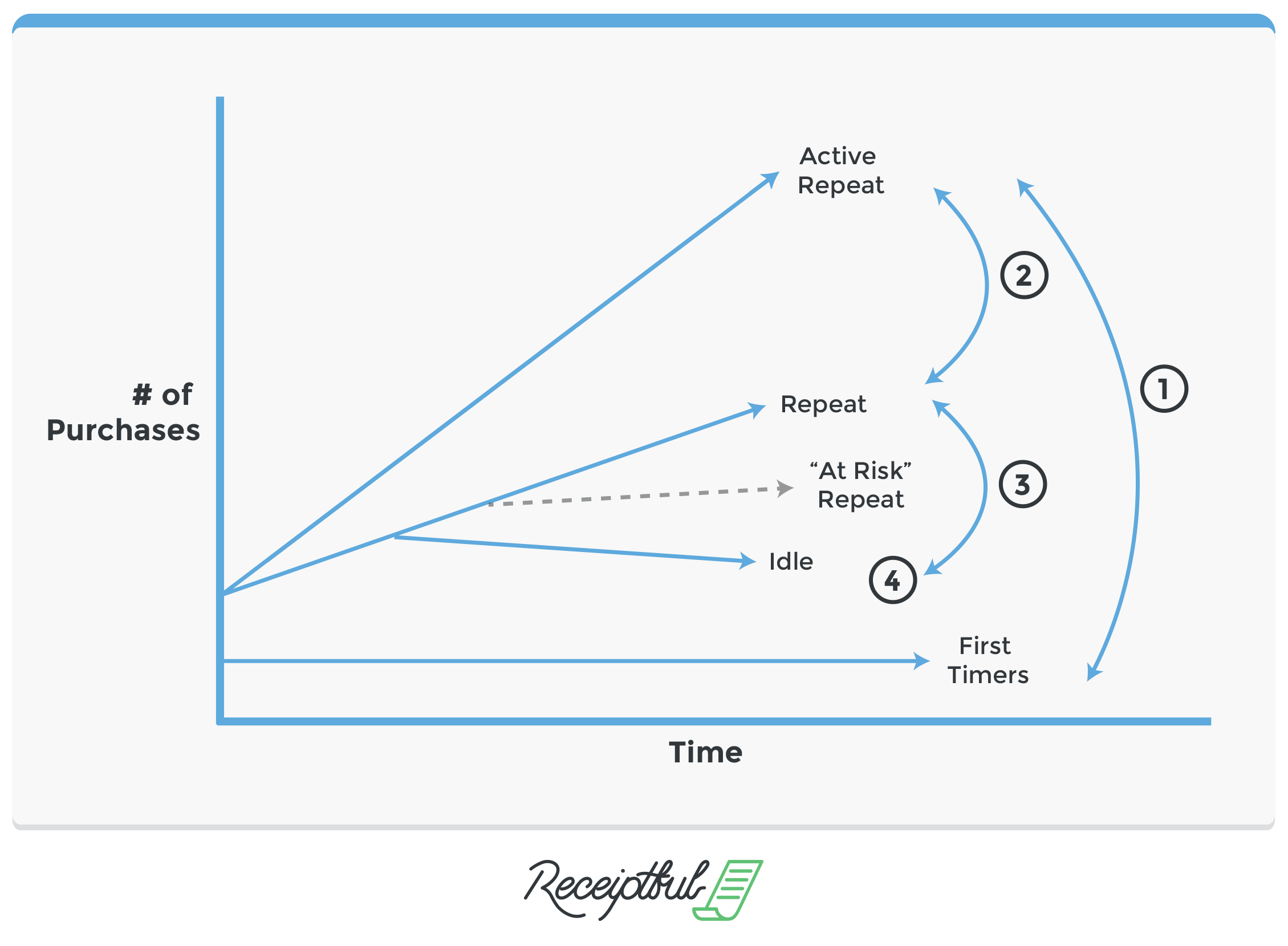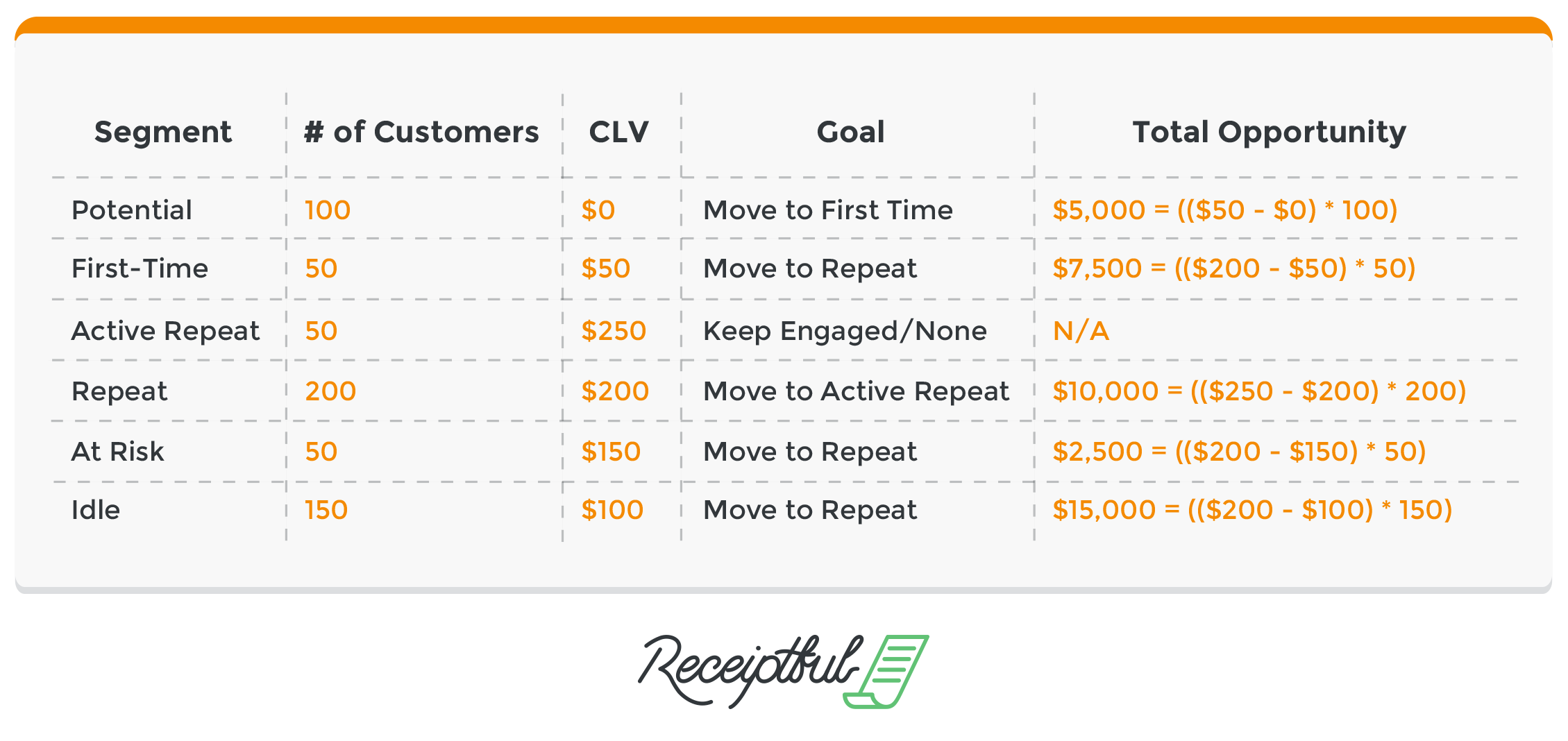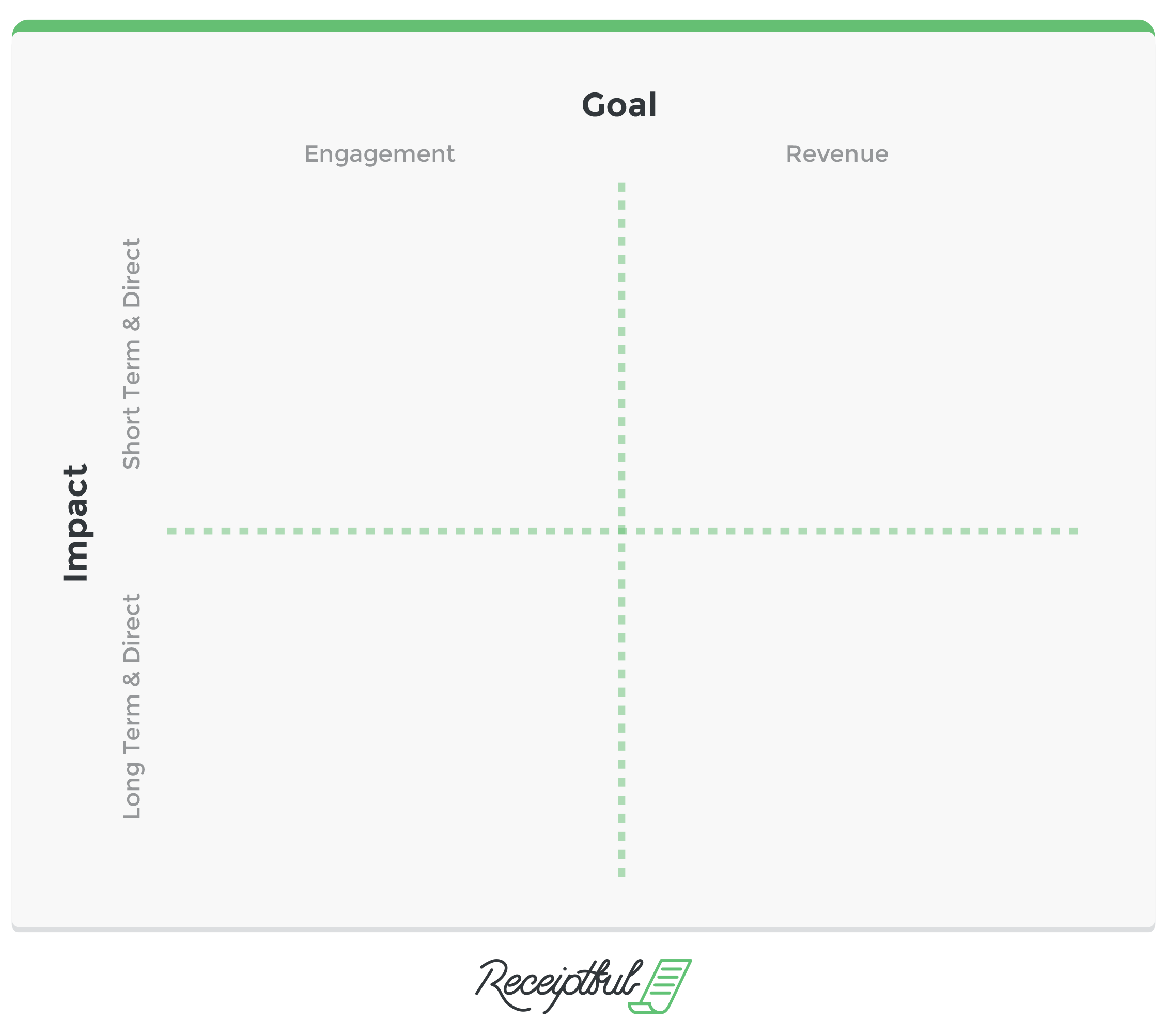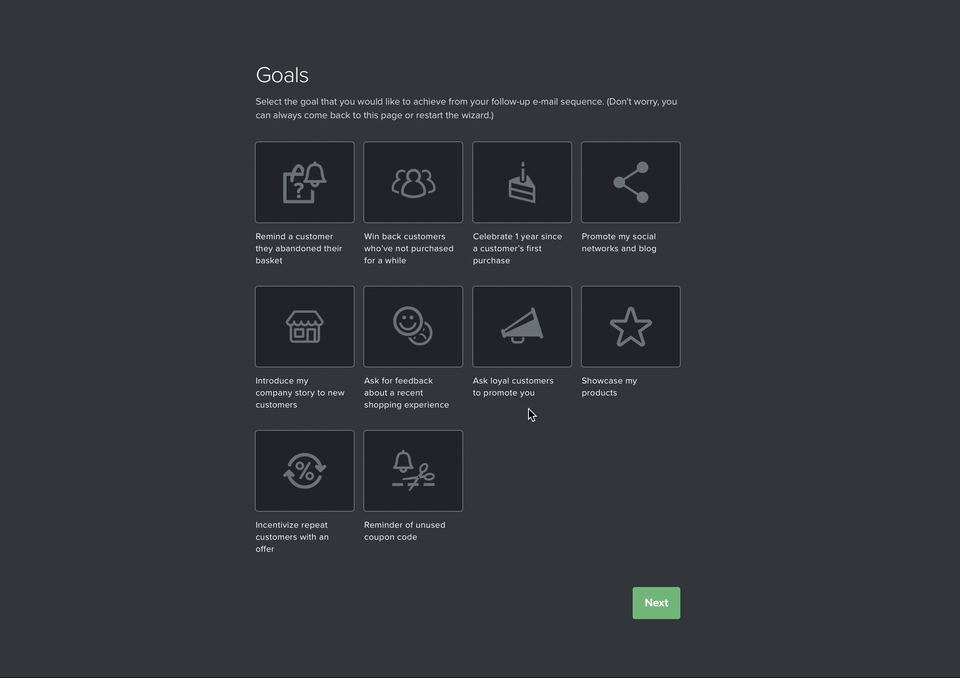Order number 1,000 is a celebration-worthy moment for any eCommerce store owner.

At this stage, you have successfully convinced hundreds of people to buy your product, and some of them may even return. However, many store owners at this point lack a clear understanding of who their customers are and how to market to different groups effectively. In fact, a recent survey we conducted at Receiptful revealed that 73% of the 252 store owners we surveyed said they did not use customer segmentation. This is unfortunate because even basic customer segmentation can greatly improve your profits.
“73% of eCommerce store owners do not use customer segmentation.”
But first, what is customer segmentation?
According to management consultants at Bain & Company, customer segmentation is: ““The subdivision of a market into discrete customer groups that share similar characteristics.” And its advantages lie in the fact that:
“Customer segmentation is a strong tool for finding unmet needs of customers. Businesses that spot underserved groups can outperform rivals by creating products and services that stand out. This approach works best when a company focuses on the most profitable segments and provides them with unique advantages. By prioritizing this way, companies can create marketing campaigns and pricing plans that maximize value from both high- and low-profit customers. A company can use customer segmentation as the main guide for distributing resources in product development, marketing, and service delivery.”
For Marketing Donut Andrew Gerrard explains customer segmentation as a marketing solution.
“It enables you to develop a deeper understanding of your customers and discover what makes them tick. When you are communicating a message, it will be more effective if the recipient of the message finds it relevant. Segmentation is simply a way of arranging your customers into smaller groups according to type. These distinct sub-groups or segments should be characterized by particular attributes. Now you can target specific, relevant marketing messages at each group. And it’s not just about what you say. How you communicate is also vital, and segmentation often requires a carefully structured marketing mix. That’s because some customers may prefer the direct approach, such as telephone marketing, while others respond better to a local advertising campaign.”
But, for scrappy store owners, customer segmentation does not come naturally. Entrepreneurs are traditionally taught to treat customers like the individuals they are. And when scaling from one to 100 orders, that is manageable. Yet, things become increasingly complex as your business grows, making it difficult to sustain highly personalized customer service and marketing efforts. When brands begin servicing hundreds of customers at a time, store owners start to take a blanket approach to promoting their products, with a universal message, targeting a single sort of consumer. And while this is a very natural progression, it is a huge mistake. With hundreds of paying shoppers, you can start to group your overall audience into different segments to better market to and service each. Despite the fact that our most recent survey shows most business owners do not use customer segmentation, we hope to influence how you allocate future marketing resources so that you prioritize personalized marketing campaigns for your unique customers.
In Receiptful’s 2016 customer segmentation survey, 73% of the 252 eCommerce store owner respondents stated that they did not use customer segmentation. The remaining 27% did, although their commitment to fully leveraging customer segmentation varied. Of the survey respondents who used customer segmentation, 23% spent an hour or less each month on segmentation marketing. 44% spent 2 to 5 hours each month, 9% spent 6 to 10 hours, 12% spent more than 10 hours each month on segmentation marketing, and 12% replied saying, “I don’t know.”
Those that truly invest in customer segmentation are outliers. For many eCommerce entrepreneurs, segmentation is an afterthought. Though, numerous studies reveal that even small attempts at segmenting your audience and customizing your marketing message can have a huge impact on your marketing performance — and sales.
When computing giant Lenovo realized that 40% of its overall online audience consisted of new, unknown visitors, the company partnered with analytics firm Neustar to segment its potential customers into different categories. In a case study, Neustar explains, “The Lenovo team’s Neustar platform cross-references this data to categorize visitors into a number of key audience groups based on product propensity and company priorities — and then shows them a specific homepage banner targeted towards their group’s preferences.” And, as a result, order conversions grew 40% and Lenovo’s average revenue per visitor increased 25%.
Store owners that customize their marketing messages for each distinct audience segment unlock hidden opportunities to engage shoppers and grow their sales. Among store owners, one of the most popular ways to use customer segmentation is through email marketing, which is also the easiest way to apply customer segmentation and measure the results of your efforts. Data from Campaign Monitor claims, “Emails with personalized subject lines are 26% more likely to be opened and marketers have found a 760% increase in email revenue from segmented campaigns.” As of June 2nd, 2016, research from MailChimp corroborates these claims. The email marketing platform found that segmented campaigns had 14.45% higher opens than non-segmented campaigns, 63.71% more clicks and 8.68% fewer unsubscribes.
With clear commercial upside to simple segmentation, it is a wonder why more store owners are not doing it. And in case you are not yet sold on the advantages of customer segmentation, here is another: the insights gleaned from segmented customer data can help direct overall business, product and marketing strategy.
A thorough analysis of who your customers are allows you to identify common themes among distinct segments. This tells you what specific groups of customers want, and how to best service them. What that also means is you may find new opportunities to cross-sell and upsell your products to specific segments, fire groups of bad (or problematic) customers and revamp your product development priorities.
Here are several examples of things you may discover:
- Upsell opportunities. While customer segmentation can reveal patterns in an individual’s purchasing behaviors, you may also start to notice trends that apply to multiple customers. For instance, a men’s grooming company may notice that 80% of customers who purchase their high-end razors (as oppose to their low-end razors) also commonly buy their shaving soaps. So, what about the remaining 20%? As a store owner, this is an opportunity to upsell those shoppers on the very same shaving soaps that your other customers seem to love.
- Some customers are prohibitively costly to retain. Your most loyal customers make frequent purchases and few — if any — returns. Problematic shoppers, on the other hand, are taxing on your customer service resources, make frequent complaints about your product’s quality and regularly return or exchange their orders. Be prepared to “fire” them as customers; attempting to salvage the relationship may be one of the worst investments you could make.
- Certain products are bad for business. With better data on your customers’ purchasing behaviors, you may find that some products are simply bad for business. An online sneaker store may notice that carrying cheap shoes attracts the wrong type of customer such as buyers who never return for repeat purchases. Furthermore, having a lot of cheap shoes on inventory may alienate other buyers who only shop from stores that stock shoes from reputable brands. Thus, you may want to consider sunsetting products that are not very profitable for you so that you can reallocate your resources — energy, money and time — towards promoting items that help you grow your business.
- Old, passive customers are low-hanging fruit. There is a widely held belief that it can cost anywhere between four and 10 times more to acquire a new customer than it would to retain an existing one. And although store owners do spend a lot of money and time engaging repeat customers, few ever give idle and inactive customers much attention. According to our 2016 customer segmentation survey, we found that roughly 54% of store owners believe that their most profitable customer segment is repeat buyers. 25% think it is first-time customers. 6% assume it is potential customers (also known as “new prospects”). 1% are convinced their most profitable type of customer is the inactive and idle customer who has made multiple purchases in the past but has not returned to place another order in a while. 14%, though, are unsure of which type of buyer is their most profitable. When given the same choices and asked about which type of customer they would label as “most important,” 42% chose repeat customers, 28% selected first-time buyers, 16% decided it was new prospects, 1% agreed it was inactive and idle customers, whilst 12% responded, “I don’t know.” Unfortunately, idle and inactive customers are not often on the top of a store owner’s priority list. However, reactivating old customers can easily become one of your biggest growth opportunities since most already like your business and have a demonstrated need for your product.
One of the earliest frameworks for customer segmentation comes from economist Vilfredo Pareto’s theory commonly known as the 80/20 rule. When applied to businesses, the general assumption is that 80% of your sales come from 20% of your customers.
The question then is: Do you know which 20%?
“Start small and with a single key variable,” suggests marketing expert Chris Hexton in an article for Marketing Land. A quick way to sabotage any real momentum you have is by overcomplicating the issue. For instance, you may use simple segmentation criteria such as customer location or customer lifetime value. Using the examples above, you may split your customer list into two by asking:
- Is this customer local or international? OR
- Which customers have spent at least $200 with us? Which ones haven’t?
In each of these, the single variable provides you with leverage in future marketing efforts. Thus, you can develop marketing campaigns that specifically target domestic customers and create completely different promotional ads for overseas buyers. For loyal shoppers who spend hundreds of dollars with you, you may want to offer always-expedited shipping and VIP customer support. For the rest of your customers, you may want to send exclusive coupons and discounts to encourage repeat purchases.
When you measure each of these marketing efforts independently, you will also begin to notice marked increases in your overall marketing performance. If after a few weeks or months you have enough resources to segment your customer list further, Dave Chaffey lists six broad customer segmentation strategies you can try:
- Demographics
- Customer lifetime value (LTV)
- Lifecycle groups
- Purchasing habits
- Multi-channel behavior and lead source
- Customer personas and psychographics
Before you fully invest in catering to any particular customer segment, Harvard Business Review editor Gretchen Gavett recommends evaluating the opportunity based on six criteria:
- The customer segment is identifiable. There are clear defining traits of your selected customer segment, and it is easy to measure their reactions to certain marketing campaigns and their purchasing behavior. As mentioned earlier, you may use demographics, customer lifetime value and more to label each customer segment.
- The customer segment is substantial. It is expensive to market to each customer segment, so make sure any group you focus on has enough members who can drive meaningful revenue. Management consultants at Bain & Company recommend, “Determine the profit potential of each segment by analyzing the revenue and cost impacts of serving each segment. Invest resources to tailor product, service, marketing and distribution programs to match the needs of each target segment.”
- The customer segment is accessible. There should be clear ways to communicate with these customers at scale, whether it is over email, social media or display advertising. Splitting your email list based on customer lifecycle is easy, however sharing targeted posts with your fans on Facebook can be hard without using the company’s advertising tools.
- The customer segment is stable. The definition for your customer segments should not change frequently. Dynamic customer segments tend to negatively impact the performance of your marketing campaigns.
- The customer segment is differentiable. Each of your customer segments should have distinct communication preferences and unique needs that they want stores to directly address. Marketers may want to consolidate groups that share the same communication preferences and needs.
- The customer segment is actionable. You should be able to design products these customers want and execute promotional campaigns that actually mobilize these buyers to take action.
One of the most common applications of customer segmentation for eCommerce businesses is with lifecycle marketing. Thus, seven ways to think of your customer list are:
1. All Customers (a.k.a. Everyone)
Start with your full customer list. Store all of their contact information (namely emails) in one place. From here, you can start creating custom segments.
Types of emails to send: Holiday promotions, new product offerings, company announcements.
Recommended email schedule: Only when necessary, and no more than twice a month.
2. Potential Customers (a.k.a. Prospects)
These customers have never purchased with you before, but have either submitted their email as part of their entry for a contest or giveaway, signed up for your email newsletter or created a shopping account and abandoned their cart before completing checkout. They have demonstrated interest in your product but they are not yet ready to commit to a purchase. There is a chance that they are reluctant to buy from you because they want to become more familiar with your brand first. Or your product currently costs more than they are willing to pay. A combination of strategic branding, targeted coupons and product education should work well to engage this type of customer.
Types of emails to send: Welcome email series, cart recovery prompts, newsletters with educational content, satisfied customer testimonials, first-order only coupons.
Recommended email schedule: A welcome email should be sent immediately after capturing their email, once again 24 hours later, another after 72 hours, then weekly.
3. First-Time Buyers (a.k.a. One-time buyers)
These are customers who have only completed a single purchase with you. With this customer segment, your goal should be to turn them into repeat buyers. However, there are several reasons why they have not yet made another purchase. For instance, some one-time buyers only needed your product for a specific need at a very specific time. Others feel your product insufficiently met their needs. Many may think your current prices are too expensive. A few may be unfamiliar with your other product offerings. Or they simply forgot about your business and need a quick reminder.
Types of emails to send: Order confirmation, new product offerings, re-ordering forms, product advice, product recommendations, educational content, customer satisfaction surveys, product review requests.
Recommended email schedule: The order confirmation email should be sent immediately after they have placed their purchase. Afterwards, you may email them up to twice a week. Of course, you may want to wait until after their order is delivered to send them product advice, customer satisfaction surveys and product review requests. A month or so after their purchase, you may prompt them with a re-ordering form.
4. Repeat Customers
Bundle shoppers who have made two or more separate purchases. These are customers who enjoyed your product enough the first time to return and place another order. Cherish these users as there is still a chance they may stop patronizing your store or that they may become brand evangelists who are loyal and regularly refer friends to your business. Respond quickly to customer service requests and experiment with ways to encourage them to place additional orders.
Types of emails to send: Order confirmation, new product offerings, re-ordering forms, product advice, product recommendations, dedicated refer-a-friend prompts, educational content, customer satisfaction surveys, product review requests, exclusive coupons for repeat customers.
Recommended email schedule: Up to three times a week.
5. Active Repeat Customers (a.k.a. Loyal customers)
Group customers who have placed multiple orders in a short time frame. Calculate the average time each customer waits between purchases. Then, label the ones who complete repeat purchases within that timeframe as “active repeat customers.” Treat these as your most valuable buyers. Active repeat customers are huge advocates of your brand and they have demonstrated time and time again that they love your product. To maintain their loyalty, consistently raise the bar on customer service and product innovation. Invite them to be a part of the brand-growing process by asking their opinion and mobilizing them to promote your business for you.
Types of emails to send: Order confirmation, early access to new product offerings, re-ordering forms, product advice, product recommendations, dedicated refer-a-friend prompts, educational content, customer satisfaction surveys, product review requests, exclusive coupons for loyal customers.
Recommended email schedule: Up to three times a week.
6. At-Risk Repeat Customers
A warning flag should be raised when a customer takes an unusually long time to return and place another order. At-risk repeat customers are characterized as shoppers who have made multiple purchases in the past but have let more time lapse since their last order than the average time all of your customers typically wait between orders. However, these are not yet considered inactive customers until the time since their last purchase has lapsed more than three times the average time your other customers spend between orders. This is an opportunity to get back on your customer’s radar, share updates about positive changes to your product or business, incentivize them to make another purchase with a coupon, or ask them why they have not purchased from you in a while.
Types of emails to send: Win-back surveys, time-sensitive coupons, “We miss you” emails, big product- or customer service-related updates.
Recommended email schedule: You may already be on thin ice with these customers, so tread carefully. Stagger your email frequency by sending no more than one a week and slowing down your pace if the customer does not respond positively to your email with a purchase.
7. Inactive Repeat Customers (a.k.a. Idle, lapsed and latent customers)
It is inevitable, but sometimes good things come to an end. You may lose touch with some of your most loyal customers. Either their needs change, your brand and product change, or they simply forget about you. Whatever the case may be, it is your job to reignite the relationship. Inactive customers are shoppers who have placed multiple orders with you before but they have not placed another order for more than three times the average time customers spend between orders. Inactive customers can be unpredictable as any number of factors may have caused them to go idle. Of course, this is your chance to figure out why they have stopped purchasing from you and how you can convince them to come back. Feel free to be creative since there is only upside in experimenting with different approaches; many of these customers have valid reasons for why they have become inactive and there might be very little chance for you to win them back unless you make major changes to the way you do business.
Types of emails to send: Major company or product announcements, big product discounts, “How can we help?” questionnaires, last-ditch emails.
Recommended email schedule: At this point, you should be prepared to send your customer a series of emails with messages being delivered no more than once a week for a month as your final attempt to win them back before you lose them entirely.
Want to be better at email marketing? Here are a few helpful resources:
7 Automated Email Campaigns That Win Customers and Keep Them Coming Back (Shopify)
Invite Your Friends! Three Best-Practices for a Successful Referral Program (MarketingProfs)
Automatic Product Recommendations for your Online Store (Receiptful)
The Best & Worst Ecommerce Emails of the 2015 Holiday Season (Elysium)
The Best & Worst Ecommerce Emails of the 2015 Holiday Season (Marketing Land)
12 Follow-up E-mails That You Should Be Sending (Receiptful)
5 Tips for Winning Triggered Email Product Review Campaigns (ClickZ)
Best Practices for Optimizing Order Confirmation Emails (Litmus)
How To Send Great Lapsed Customer Win-Back Emails (Ometria)
Smart Strategies for Issuing eCommerce Coupons (Receiptful)
When we, at Receiptful, look at a store’s customer data and when we plot customer segments based on their purchase volume and frequency, we observe a graph that looks a lot like the Standard Bell Curve. What this implies is that the normal distribution of customers (across their various segments) will look very similar from one store to the next (even if those stores are nothing alike).
Typically, it takes a little while for first-time customers to return and complete their second purchase since they need to receive the product, use it and enjoy it before they can confidently place a follow-up order. However, many forever remain as first-time customers until they complete another purchase. Active repeat customers place multiple orders in a relatively short timeframe because they use your product extensively. Regular repeat customers, on the other hand, enjoy your product but do not consider it essential to everyday life and, thus, take a bit longer to return and make another purchase. At-risk repeat buyers are not particularly frequent customers. Idle customers tend to wait painfully long times to return and place another order, if they ever come back. Fortunately though, there are plenty of opportunities to win these shoppers back and turn them into repeat buyers again.
Are you finally convinced about the power and potential of customer segmentation? If so, keep reading. Well, we’ll show you our custom three-step process.
Before you dive deep into customer segmentation, it may be helpful to visualize the standard customer lifecycle or journey. The above chart shows how a prospect converts into a first-time buyer, then becomes a repeat customer, gets flagged as an “at-risk client,” then becomes an idle customer which store owners can either win-back or lose forever.
To harness the power of customer segmentation, you need to find opportunities to influence different consumer groups, weigh the potential impact of marketing to specific segments and execute on a pre-determined strategy.
1. Set clear goals per customer segment and identify potential growth opportunities based on value gaps
With each distinct customer segment comes a unique set of opportunities to increase those consumers’ average lifetime value. What store owners must do first though is list a specific goal they hope to achieve with each customer segment.
Using the customer lifecycle as a segmentation framework, we believe that the five primary goals stores owners can focus on are:
- Move Potential Customers to First-Time Buyers
- Move First-Time Buyers to Repeat
- Keep Repeat Customers active (in other words, move Repeat Customers to Active Repeat Customers)
- Move At-Risk Customers back to Repeat
- Win-back Idle Customers
After declaring your goals, store owners should conduct a gap analysis, which Udemy’s Kasia Mikoluk defines as: “[The comparison of] the gap between an organization’s actual performance against its potential performance.” At this point it will be clear where your biggest growth opportunities exist. Below, we’ve illustrated how this may look.
2. Estimate the additional value generated from marketing to specific segments
After deciding the broader goals you hope to accomplish in marketing to specific customer segments, your next step should be to quantify what you stand to gain from each initiative. The goal here is to determine your priorities and estimate the size of the opportunity. With limited resources, such as cash, effort and time, store owners have to be strategic in their approach. Very few, if any, eCommerce businesses are in the position to go full throttle on all these opportunities.
To clarify how this works, we have developed a template which you can use for your own business. And here we have included one way this may look:
In the first column, we list the six individual stages of the customer lifecycle, which we are also using to distinguish customer segments. In the second column, we quantify the number of customers in each group. The third column shows the customer lifetime value (CLV) of an average customer in that particular segment. The fourth column states your expected outcome in marketing to that specific customer segment. The final column calculates how much additional revenue you can generate if you successfully accomplish your pre-determined goal for all your customers in that segment.
We define “Total Opportunity” as a function of ((goal segment CLV – current segment CLV) * # of customers). Specifically:
- Take the goal / target segment’s CLV.
- Deduct the current segment’s CLV which results in the potential opportunity.
- Multiply by the # of customers that you could move (assuming you could move all) to determine the total opportunity.
In the above illustration we find that idle customers present the biggest revenue growth opportunity. However, this is not an absolute truth for all businesses. Plug your own figures into columns 2 & 3 to see where you might be able to generate the most additional value.
Check it out!
We’ve put together a free spreadsheet so that you can see how this works using your own figures.
Open Doc
For the most part, your segmentation marketing priorities will be dependent on two factors:
- The number of customers in each segment.
- The difference in customer lifetime value (CLV) between “current” and “goal” segments.
Of course, one harder-to-quantify consideration can be how easy or difficult it may be to accomplish your set-out goal for each particular segment. Using the earlier example, that would mean moving customers from one lifecycle stage to another. Naturally though, convincing idle customers to return and become repeat customers once again may prove be a more resource-intensive project than simply engaging regular repeat customers and turning them into active repeat buyers.
3. Implement tactics to address each opportunity
Receiptful’s 2016 customer segmentation survey revealed that only 37% of store owners segment their customer lists; 63% do not. Among those that do use actively differentiate between customers, 25% stated that they always customize their content for each distinct buyer segment while 66% said they sometimes do this and 9% say they never do this. As we have mentioned throughout this guide, store owners have largely neglected customer segmentation. And although you may have read all of our advice so far, here is where we challenge you to fully execute a segmentation marketing campaign.
Several concrete tactics for each segmentation goal include:
- Move Potential Customers to First-Time Buyers
- Welcome email series
- Abandoned cart campaign
- Drip email campaign
- Retargeting ads across display networks and on social media
- Move First-Time Buyers to Repeat
- Welcome email series
- Post-purchase email series
- Targeted digital receipt offers
- Regular email newsletters with promotional campaigns (and discounts)
- Direct mail catalogs, coupons or free product samples
- Keep Repeat Customers active (in other words, move Repeat Customers to Active Repeat Customers)
- Post-purchase email series
- Email newsletter with exclusive content
- Order replenishment/repurchasing reminders
- Direct mail catalogs, coupons or free product samples
- Free expedited shipping offers
- Targeted pop-up shops in areas with high concentration of repeat customers
- Move At-Risk Customers back to Repeat
- Anniversary emails
- “We miss you” prompts
- Time-sensitive coupons
- Retargeting ads across display networks and on social media
- Win-back Idle Customers
- Win-back campaign
- Anniversary emails
- “How can we help?” questionnaires
- Big company announcements
- Retargeting ads across display networks and on social media
- Direct mail catalogs, coupons or free product samples
A helpful way to organize each segmentation opportunity is by utilizing the above 2-by-2 matrix. For every tactic, it is crucial that you consider its primary goal (revenue generation or customer engagement) as well as its expected timeframe (short or long) and impact (direct or indirect). Some segmentation approaches might be a combination of all of these too. Generally, you may want to prioritize any things that fall into the upper-right quadrant to drive direct revenue quickly.
We didn’t create this guide as a way to promote Receiptful. But if you are reading this and you are already using the Receiptful platform, we wanted to give you a quick overview of how segmentation works within our eCommerce marketing product.
The first question then is: How does customer segmentation work within Receiptful? You would be happy to know that we handle the segmentation of your customer lists in a completely automated way, which means segmenting your customers is one less item you have to check off on your overflowing to-do list.
In defining your customer segments, we consider your customers’ order history and two metrics specifically:
- The number of orders purchased for a particular customer.
- Dates and times when they placed those orders.
With these metrics and a little bit of magic, we then create your default customer segments (more info about these segments in our product documentation):
- First-Time Buyers
- Repeat Customers
- Active Repeat Customers
- “At Risk” Repeat Customers
- Inactive Repeat Customers
- Potential Buyers
Receiptful will also keep these segments up-to-date based on your customers’ actual purchasing behavior. So if an “At Risk” Repeat Customer makes a purchase today, they will automatically move to the Active Repeat Customers segment.
The second question is: How you are able to use these segments? These segments are available to all of your email campaigns, which means you can send a specific email only to a specific segment if you wanted to do that.
Once you have identified your goals and the opportunity available via each of your customer segments, you will want to create emails (or sequences and series) that engage with customers in those segments.
To help you with this, we have an easy-to-use Follow Up Email Wizard which sets the emails up for you based on the goal you would like to achieve. Have a look at how quick and easy it is to use the Wizard:
Check out segmentation within Receiptful→
Note: If you need help with our customer segmentation tools in Receiptful or you have any questions about this, please feel free to give us a shout.
One of the most important steps that busy store owners (understandably) skip is taking the time to reflect on their experience with customer segmentation to gather a fuller understanding of why and how smart segmentation can positively impact their bottom line. The more an eCommerce entrepreneur can quantify the ROI of his or her segmentation efforts, the more he or she will continue to allocate resources towards future segmentation campaigns.
“Roughly half of all eCommerce store owners cannot correctly identify their most important and most profitable customer segments.”
In our 2016 customer segmentation survey, we asked respondents to select which customer segments they believed were most important for their business and which ones were the most profitable. What we discovered was a major gap in their understanding of who their best customers were and why.
- 52.78% of individuals who were confident they knew which customer segment was most important for their business also responded that they were unsure of which one was their most profitable. That’s frightening.
- Furthermore, there is a huge misalignment between what people believe is their most important and most profitable customer segment. In fact, 48.02% of store owners chose differently for both.
After you implement your customer segmentation strategy, be sure to budget resources towards analyzing the results and optimizing your future efforts. There should be no confusion between your most important and most profitable customer segments. The key to ongoing success among any marketing efforts is measurement and constant improvement. Budget time each month to review your progress and identify ways to upgrade your customer segmentation campaigns.
Ready to get started with your next customer segmentation campaign? Check it out in Receiptful
Read more: 5 Expert Ways to Increase Your eCommerce Customer Service
